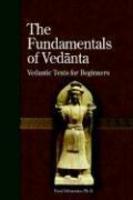
Book Summary
"Fundamentals of Vedanta, Part One" is a translation, with a detailed introduction and notes, of two short Sanskrit texts, the Vedanta-sara (Essence of Vedanta) of Sadananda and the Prameya-ratnavali (Necklace of Turht-Jewels) of Baladeva, that have been used in India for centuries to introduce beginning students to the fundamental ideas of Vedanta. (World Religions) Vedanta is one of the six orthodox philosophical schools of the Hindu tradition, orthodox because they profess to accept the authority of the ancient Vedas as revelation. Vedanta is the school that attempts to discover in the final portions of the Vedic texts, known as the Upanishads, a consistent religious and philosophical way of seeing reality tattva-darshana). The "school" of Vedanta is really a family of schools, all of its members sharing the belief that there is a single consistent "way of seeing" presented in the Upanishads, but whose hermeneutic efforts often have led to radically different conclusions. Within this family of Vedantic schools the spectrum ranges from the absolute monism, or more correctly the non-dualism, of the Advaita sub-school to the quasi-dualistic theism of the Dvaita sub-school. Fundamentals of Vedanta, Part One is a translation, with a detailed introduction and notes, of two short Sanskrit texts, the Vedanta-sara (Essence of Vedanta) of Sadananda and the Prameya-ratnavali (Necklace of Turht-Jewels) of Baladeva, from opposite ends of the Vedantic spectrum, that have been used in India for centuries to introduce beginning students to the fundamental ideas of Vedanta. Generations of Indian students received their first exposure to Vedantic ideas from one or both of these texts, and thus they form an excellent starting point for modern readers who are interested in knowing more about the rich intellectual and religious world of Vedanta. From the Introduction: Anyone who has walked, either actually or sympathetically, some distance down the path of Advaita Vedanta, far enough at least to get a glimpse of the Advaitin's world, will be able to attest to what apowerful vision of reality it is and to what a relief and joy the transforming experience of Brahman must be. As part of that experience the burden of one's fears, disappointments, anxieties, losses, frustrations, and limitations is lifted off one's shoulders and one realizes one's true nature as unending consciousness and joy. In that moment when one realizes that there is no other," one's fear vanishes for it is the other" that one feared, and even when the "other" is a source of joy, as the other" often is, that joy is always conditioned by fear, the fear of loss. The joy of Brahman is unlimited and unconditioned by fear.'' Neal Delmonico received his Ph.D. from the University of Chicago in South Asian Languages and Civilizations in 1990. He has published numerous articles on Caitanya Vaishnavism and has done several translations from Sanskrit and Bengali into English. Dr. Delmonico taught for six years in the Religious Studies Program at Iowa State University, and, most recently (2001), was a visiting assistant professor in Philosophy and Religious Studies at Truman State University. He is currently working on a series of translations and commentaries on some of the fundamental texts of Indic religion and philosophy, like the ones presented here, and collaborating on an online Sanskrit text repository called the Gaudiya Grantha Mandira (www.granthamandira.org).
Book Details
| Book Name | The Fundamentals Of Vedanta |
| Author | Sadananda Yogindra, Baladeva Vidyabhusana, Neal G. Delmonico |
| Publisher | Blazing Sapphire Press (Feb 2006) |
| ISBN | 9780974796833 |
| Pages | 288 |
| Language | English |
| Price | 1144 |








